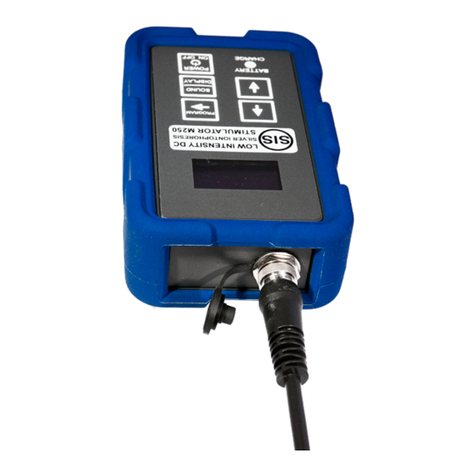SIS MACHINE W250 MODEL OPERATING MANUAL
8. ELECTROTHERAPY ELECTRODE↔SKIN
CONTACT
Electrical resistance, which is part of total electrical impedance to the flow of
electric current, is measured in units of Ohms (Ω):
1 megaOhm (MΩ) = 1000 kiloOhm (kΩ) = 1,000,000Ω
The total circuit resistance during non-invasive electrotherapy stimulation via
any pair of any type of electrotherapy electrode is the sum of the electrical
resistances at both the electrode↔skin/body contact areas, plus the internal
body electrical resistance(s) in the pathway(s) of electric current between the
two electrodes. Large variations in total circuit resistance up in to the MΩ
range can occur depending on many device-related and bioelectric factors.
NOTE: A major factor that affects electrode↔skin/wound contact area
electrical resistances is moisture; the wetter these areas the lower their
contributing electrical resistances to the total circuit resistance.
B OELECTR C WOUND ASSESSMENT: Bioelectrically, as a wound or ulcer
heals, the through-wound electrical resistance linearly increases. f the
electrode↔skin/wound contact electrical conductivity factors are held
relatively constant over time, or if their known dynamics are calibrated out of
the total circuit resistance measurements, the target through-wound electrical
resistance measurements can be reliably obtained, at regular measurement
intervals. This methodology can enable bioelectric data based assessment of
(rate of) wound healing.
W250 FUNCTIONS
Total circuit resistance is shown in the ST M DATA screen as RES and
updates every 30 seconds with an average value of multiple real-time
measurements. The W250 continuously and rapidly self-adapts to the
electrical resistance dynamics of the electrode↔skin/wound contact areas.
The device-generated Output Voltage is shown in the ST M DATA screen as
VOLTS. An Output Voltage level and spike monitoring algorithm assesses 10
minute stimulation periods at a time, and is calibrated in relation to a
relatively low ≤ 50-100 kΩ RES value, in order to assess early possibility of
intact (non-wound) skin irritation during extended device application.
Page 18. SIS MANUFACTURING LTD, NZ. JANUARY 2019.





































